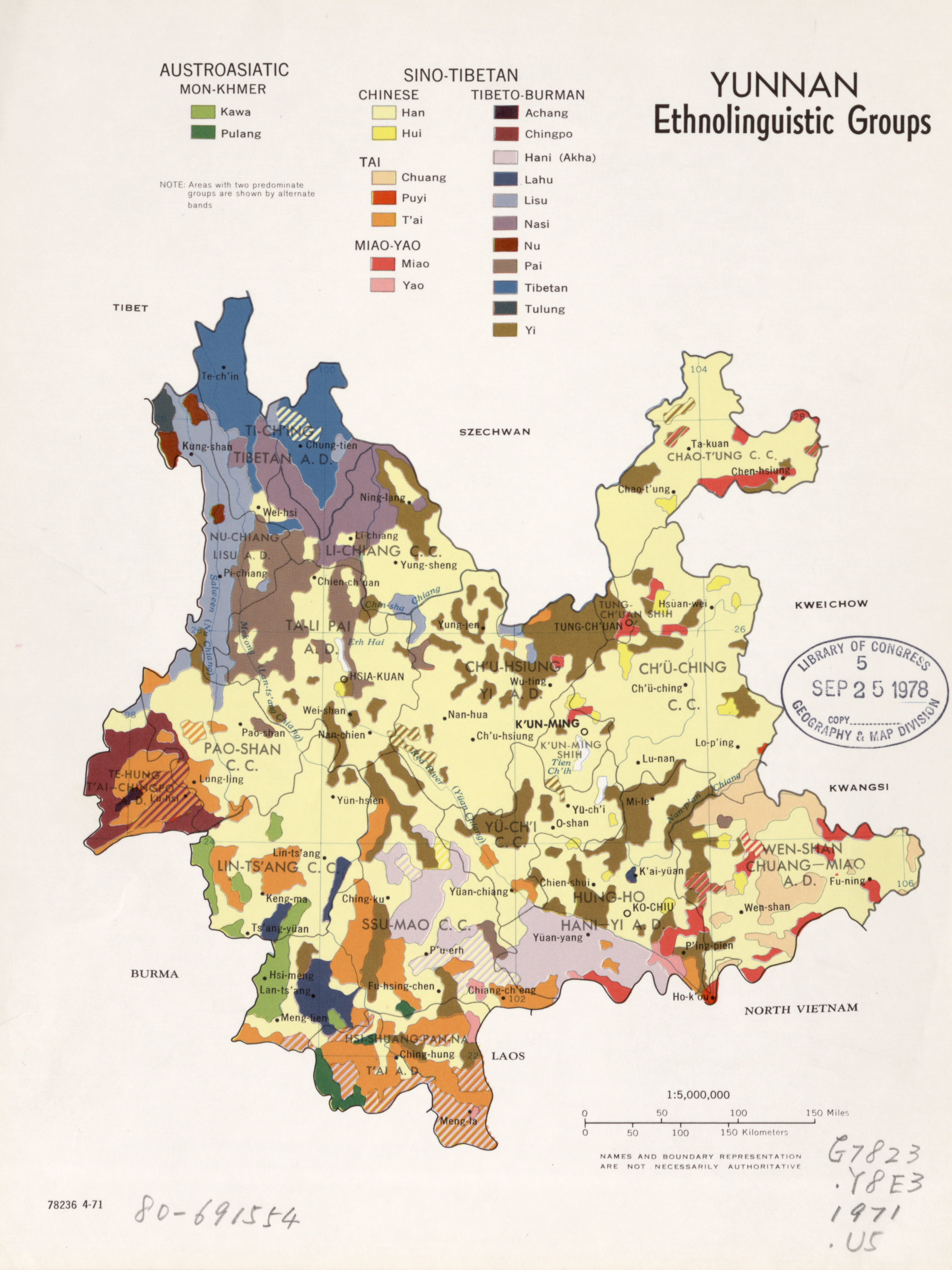Lolo-Burmese on:
[Wikipedia]
[Google]
[Amazon]

 The Lolo-Burmese languages (also Burmic languages) of
The Lolo-Burmese languages (also Burmic languages) of

Burma
Myanmar, ; UK pronunciations: US pronunciations incl. . Note: Wikipedia's IPA conventions require indicating /r/ even in British English although only some British English speakers pronounce r at the end of syllables. As John Wells explai ...
and Southern China
South China () is a geographical and cultural region that covers the southernmost part of China. Its precise meaning varies with context. A notable feature of South China in comparison to the rest of China is that most of its citizens are not n ...
form a coherent branch of the Sino-Tibetan family.
Names
Until ca. 1950, the endonym ''Lolo'' was written with derogatory characters in Chinese, and for this reason has sometimes been avoided. Shafer (1966ŌĆō1974) used the term "Burmic" for the Lolo-Burmese languages. The Chinese term is ''MianŌĆōYi'', after the Chinese name for Burmese and one of several words for Tai, reassigned to replace ''Lolo'' by the Chinese government after 1950.Possible languages
The position of Naxi (Moso) within the family is unclear, and it is often left as a third branch besides Loloish and Burmish. Lama (2012) considers it to be a branch of Loloish, whileGuillaume Jacques
Guillaume Jacques (, b. 1979) is a French linguist who specializes in the study of Sino-Tibetan languages: Old Chinese, Tangut, Tibetan, Gyalrongic and Kiranti languages. He also performs research on the Algonquian and Siouan language families ...
has suggested that it is a Qiangic language.
The Pyu language that preceded Burmese in Burma is sometimes linked to the Lolo-Burmese family, but there is no good evidence for any particular classification, and it is best left unclassified within Sino-Tibetan.
L├Čffler (1966) and Bradley (1997) consider the Mru language
Mru, also known as Mrung (Murung), is a Sino-Tibetan language of Bangladesh and Myanmar. It is spoken by a community of Mrus (Mros) inhabiting the Chittagong Hill Tracts of Bangladesh with a population of 22,000 according to the 1991 census, ...
to be closely related to or part of Lolo-Burmese, while Matisoff includes Mruic in the Northeast India
, native_name_lang = mni
, settlement_type =
, image_skyline =
, image_alt =
, image_caption =
, motto =
, image_map = Northeast india.png
, ...
n areal group.
Pai-lang
Bailang or Pai-lang () is the earliest recorded Tibeto-Burman languages, Tibeto-Burman language, known from three short songs, totalling 44 four-syllable lines, recorded in a commentary on the ''Book of the Later Han''. The language is clearly ei ...
, attested from the 3rd century, is Lolo-Burmese, perhaps Loloish.
External relationships
Guillaume Jacques
Guillaume Jacques (, b. 1979) is a French linguist who specializes in the study of Sino-Tibetan languages: Old Chinese, Tangut, Tibetan, Gyalrongic and Kiranti languages. He also performs research on the Algonquian and Siouan language families ...
& Alexis Michaud (2011) argue for a Burmo-Qiangic branch with two primary subbranches, Na- Qiangic (i.e. Naxi-Qiangic) and Lolo-Burmese. Similarly, David Bradley (2008) also proposes an Eastern Tibeto-Burman branch that includes the two subbranches of Burmic ( Lolo-Burmese) and Qiangic.
Internal classification
Bradley (1997, quoted in Peiros 1997) gives the following classification for the Lolo-Burmese languages. In later publications, in place of ''Loloish'', David Bradley instead uses the term ''Ngwi'' based on a conservativeautonym
Autonym may refer to:
* Autonym, the name used by a person to refer to themselves or their language; see Exonym and endonym
* Autonym (botany), an automatically created infrageneric or infraspecific name
See also
* Nominotypical subspecies, in zo ...
in the Sanie language.
*Lolo-Burmese
** Mru
**Core Lolo-Burmese
***UgongŌĆōBurmish
**** Ugong
**** Burmish
***Loloish
The Loloish languages, also known as Yi in China and occasionally Ngwi or Nisoic, are a family of fifty to a hundred Sino-Tibetan languages spoken primarily in the Yunnan province of China. They are most closely related to Burmese and its relat ...
(Ngwi)
Lama (2012), in a study of 36 languages, finds the Mondzish cluster ( MondziŌĆō Maang, MantsiŌĆōMo'ang) to be divergent. He did not include Mru or Ugong.
*Lolo-Burmese (Niso-Burmic)
** Mondzish
**Core Lolo-Burmese
*** Burmish (Burmic)
***Loloish
The Loloish languages, also known as Yi in China and occasionally Ngwi or Nisoic, are a family of fifty to a hundred Sino-Tibetan languages spoken primarily in the Yunnan province of China. They are most closely related to Burmese and its relat ...
(Nisoic, Ngwi)
Lama (2012) recognizes 9 unambiguous coherent groups of Lolo-Burmese languages, whereas Bradley considers there to be 5 groups (Burmish, Southern Ngwi, Northern Ngwi, Southeastern Ngwi, and Central Ngwi).
# Mondzish
# Burmish
# Hanoish
# Lahoish
# Naxish
# Nusoish
# Kazhuoish
# Lisoish
# Nisoish
See also
*Proto-Loloish language
Proto-Loloish is the reconstructed ancestor of the Loloish languages. Reconstructions include those of David Bradley (1979), James Matisoff (2003), and Ziwo Lama (2012).
In later publications, in place of ''Loloish'', David Bradley instead uses ...
References
Bibliography
* * * *Huang, Bufan ╗äÕĖāÕćĪ ed. (1992). ''A Tibeto-Burman Lexicon'' (''TBL'') ŚÅń╝ģĶ»ŁµŚÅĶ»ŁĶ©ĆĶ»Źµ▒ć Beijing: Minzu University Press ĖŁÕż«µ░æµŚÅÕŁ”ķÖóÕć║ńēłńżŠ * *Satterthwaite-Phillips, Damian. 2011. ''Phylogenetic inference of the Tibeto-Burman languages or On the usefulness of lexicostatistics (and "Megalo"-comparison) for the subgrouping of Tibeto-Burman''. Ph.D. dissertation, Stanford University. * *Yunnan Province Geography Gazetteer Committee ║æÕŹŚń£üÕ£░µ¢╣Õ┐Śń╝¢ń║éÕ¦öÕæśõ╝Ü(1998). ''Yunnan Province Gazetteer, volume 59: ethnic minority languages and orthographies gazetteer'' ║æÕŹŚń£üÕ┐ŚÕŹĘ59: Õ░æµĢ░µ░æµŚÅĶ»ŁĶ©Ćµ¢ćÕŁŚÕ┐Ś Kunming: Yunnan People's Press ║æÕŹŚõ║║µ░æÕć║ńēłńżŠ *''Zangmian yuyin he cihui'' (''ZMYYC'') ŚÅń╝ģĶ»ŁĶ»Łķ¤│ÕÆīĶ»Źµ▒ć(1991). Beijing: Social Sciences Press ĖŁÕøĮńżŠõ╝Üń¦æÕŁ”Õć║ńēłńżŠ {{Lolo-Burmese languages Languages of India Languages of Myanmar